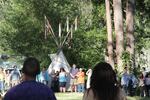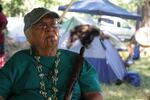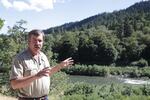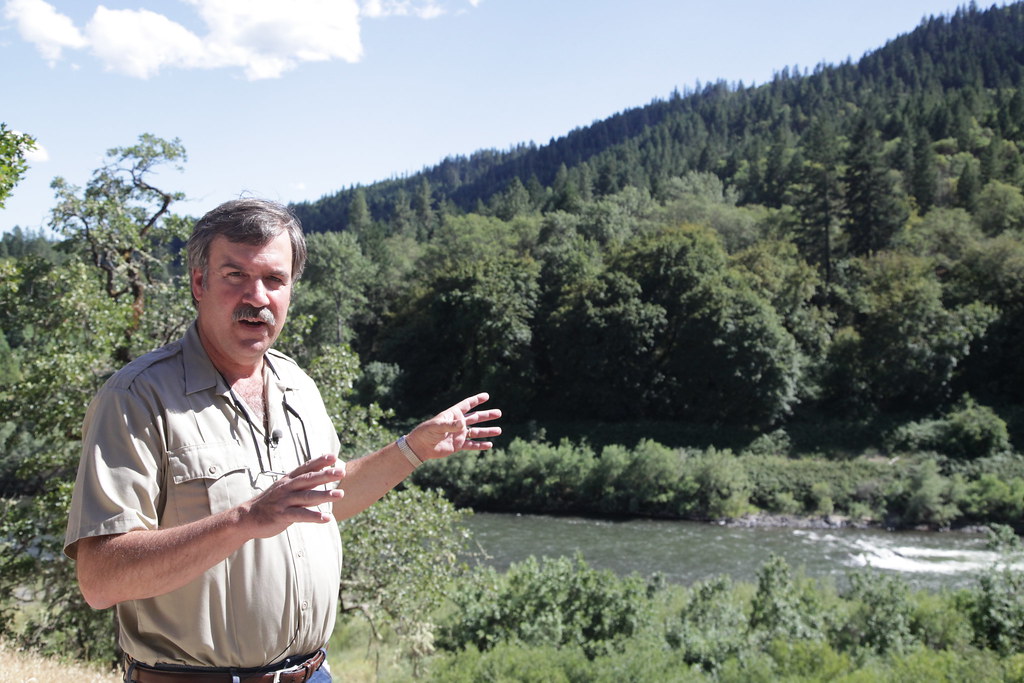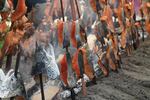
The Rogue River Indians “first salmon” ceremony ends in a feast. This weekend the cooks prepared enough salmon to feed 700 people.
Pat Kruis
Just outside of Southern Oregon's Gold Hill, under the shade of towering oaks, one hundred faithful stand single file to partake of the ceremonial first salmon of the year.
Agnes Pilgrim, a youthful 89, presides. People affectionately call her Grandma Aggie. She is the oldest living descendent of the Takelma tribe, now part of the Siletz Confederated Tribes.
As they finish eating everyone carefully places the bones and the skin in a large wooden bowl carved in the shape of a fish. Out of sight, four men sit in a sweat lodge, purifying themselves for what comes next.
“Bring out the divers!” calls Grandma Aggie. The men come out from the sweat lodge and she places a portion of fish remains on the cedar boughs the divers hold.
Only an elite circle is allowed to see the key moment of this rite. One purified man climbs atop a rock, dives in and returns the remains of the salmon to the river, honoring the salmon for giving its life to feed them.
Pilgrim says her ancestors performed this ceremony for thousands of years, until 1856 when treaties removed the tribes from the Rogue River. She revived the ritual 20 years ago.
“This is what I’m carrying on, my people’s unfinished work,” says Pilgrim. “I know that when they have done that in such a sincere and humble way, I know that our beloved Creator will bless that river.”
People tell Grandma Aggie, and she believes, that salmon runs have improved since the ceremony began.
It’s been a mixed bag says Oregon Department of Fish and Wildlife biologist Dan Van Dyke. “I can tell you that we’ve had highs and lows in the last 20 years.”
_Estimated number of fall chinook returning to the Rogue River above Huntley Park at about river mile 8, based on ODFW seining project. The top line is the number of wild fish. Courtesy of ODFW._
Statistics from the ODFW show in 2002 and 2004 some salmon species on the Rogue registered their highest counts since 1942. Since then numbers have dipped, but are on the rise again.
“Generally in Oregon in that time period we’ve seen an emphasis, a refocusing on watershed health.” Van Dyke points out that three dams have been removed in the past few years. “There’s been more funding on fish enhancement in that time period.”
While public sentiment has grown more favorable to fish, population growth creates new challenges.
“Here we’re looking at 90 and 100 degree temperatures over the next week and you can literally watch the river gauges at different points on the Rogue and see the amount of water decreasing at the different sites on the Rogue just from human consumption.”
Van Dyke says a twenty-year snap shot isn’t enough to predict a river’s future.
“I think it will be the next real bad period where we’ve got a multi-year drought and poor ocean conditions. I think seeing how the fish do during that period, that’s going to be the next real test. And if we pass that with flying colors and keep those fish around for future generations that’ll be one of the signs that we’re really making progress.”
